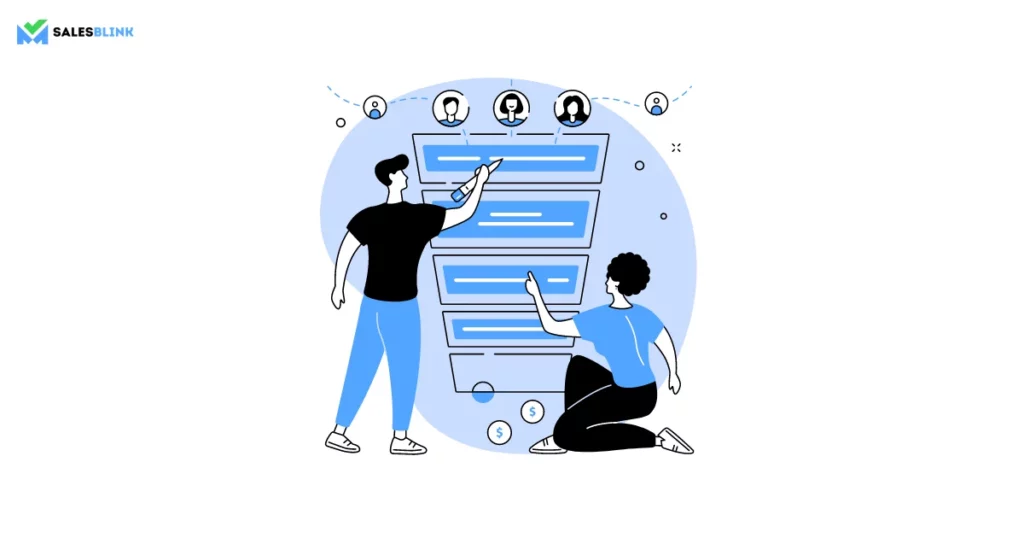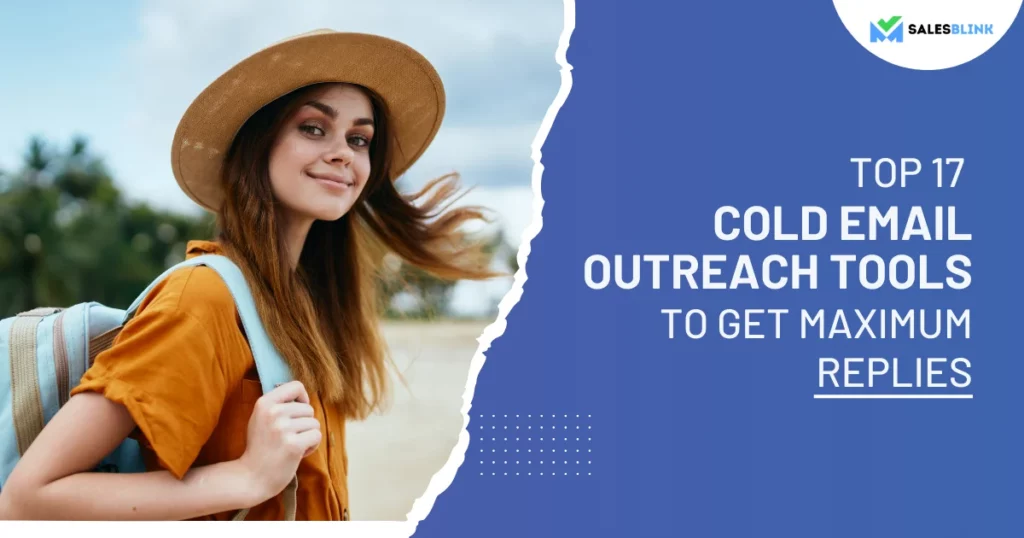Effective Outbound Sales Strategy You Must Know
Do you want to meet your sales target effectively? You may need different sales strategies, including inbound and outbound sales, to achieve this goal.
Outbound sales have 38% higher conversion rates than inbound sales. Knowing the power of outbound sales is crucial for any business. It helps sustain old customers and boosts revenue while attracting new customers. This increases conversions effectively and speeds up business growth.
In this blog, you will learn about outbound sales strategies and how they can improve your sales. We will discuss ways to find clients and use personalized outreach. You will also learn how SalesBlink helps with outbound sales and converts more leads into customers.
Table of Contents
What is Outbound Sales?
Today, customers expect engaging interactions with businesses. Outbound sales strategies meet these expectations and build strong connections. They offer a more promising future for business growth than other strategies.
Simply put, outbound sales means actively reaching out to potential customers. Sales teams contact them through phone calls, emails, and messaging apps like WhatsApp. The goal is to find, nurture, and convert prospects into customers.
Outbound sales can be challenging due to cold outreach and customer resistance. However, it is important in many sales strategies. With the right approach, it can:
- Increase revenue from new and existing customers
- Expand the customer base and build relationships
- Improve sales efficiency and adapt to customer needs
- Increase brand visibility in the market
- Educate customers
- Get feedback for improvements
A good outbound sales strategy targets specific markets and customer groups. It makes personalized interaction a great way it to convince people to buy from you.
What is the Difference between Inbound and Outbound Sales?
These two sales methods differ in who starts the contact. Outbound sales is when businesses contact potential customers through calls, emails, or campaigns. Inbound sales, customers contact the business through websites, social media, emails, or calls. Inbound sales use content and marketing to attract and engage customers.
B2B outbound sales strategies aim to find and persuade clients to buy or subscribe. Salespeople target specific markets to build a strong base and find potential clients. This involves researching leads, making contact, and nurturing them through the sales process.
Inbound sales focus on creating content and plans to attract customers naturally. The goal is to generate interest and persuade customers to engage with the business. Sales rep help answer questions and solve issues to turn their interest into purchases.
Both inbound and outbound sales are good, but outbound sales make you more active with clients. Direct contact helps personalize your approach, understand needs better, and send custom messages. It also provides quick feedback, helping quickly improve strategies, products, and services. This expands the customer base and introduces new products or services.
An outbound sales strategy is a full plan to reach and engage customers as much as possible
Types Of Outbound Sales Reps

Are you a Sales Development Representative (SDR) or an Account Executive (AE)? If so, effective outbound sales can help you achieve your goals.
Sales Development Representative (SDR)
SDRs find new customers and check their scope, reaching out through calls, emails, and more. They research, identify decision-makers, and create a pipeline of leads for Account Executives.
They use CRM tools to track interactions and schedule meetings or demos. Additionally, they gather important information on prospects’ needs and challenges.
A strong outbound sales strategy helps SDRs target the right audience. Personalized approaches and CRM tools help with all the steps needed for outbound sales. In turn, this increases the chances of successful sales and business growth.
Account Executive (AE)
Meeting sales targets requires effective communication, negotiation skills, and deep product knowledge. AEs finalize deals and manage client relationships. They work closely with SDRs to understand lead requirements and adjust their pitches.
AEs explain products/services and discuss contracts to turn possible clients into actual buyers.
SDRs share the leads they find with AEs for further discussion and conversion. AEs customize solutions to meet customer needs, build trust, and close deals effectively. They stay updated on industry trends to refine their sales strategies.
Effective outbound sales strategies help SDRs find and guide high-quality leads. These help AEs engage strategically with prospects, build strong ties, and close deals.
Key Benefits Of Outbound Sales

Now that you know who benefits from SAAS outbound sales strategy, let’s see how it can help your business grow and succeed.
Instant Interaction with Clients
Outbound sales provide quick customer feedback. This improves sales strategies, products, and services quickly. It also makes it easier to answer questions and move forward smoothly.
Prospect Targeting
Showing your product or service to the right people at the right time builds strong relationships. It can help you sell more, with people responding quickly to your offer.
Personalization
Outbound sales let you tailor messages to match each prospect’s needs. Your outreach becomes more engaging and shows you value their interests. This personalized approach can greatly improve response rates and your overall sales efforts.
Better Engagement
By reaching out directly through calls, emails, or texts, you can have meaningful discussions with prospects. You will gain credibility and show how your products or services are beneficial.
Scalability
B2B outbound sales strategy can be adjusted and expanded as needed. You can change your approach to fit your goals and grow your business. This flexibility helps you adapt to market changes and seize growth opportunities.
Feedback
Outbound sales responses come from talking to potential customers. Such feedback is important for determining what works or needs improvement. Observing it lets you refine your approach continuously for better results.
Resource Optimization
Outbound sales strategies help you use your resources more effectively. By focusing on the best potential customers, you can save time and energy, leading to better results.
Competitive Advantage
Using a good outbound sales strategy can give you an edge over your competitors. By reaching out to potential customers first, you can stay ahead of those who wait for customers to come to them. This proactive approach can help you win more customers.
SalesBlink helps you expand your sales activities and achieve more success in less time. We help you maximize your outbound sales methods. Our free and paid tools make finding new customers easier, get more leads, and sell more efficiently. Our platform provides resources like FAQs, blogs, case studies, and more to support your business goals.
Step for Outreach Sales Process Via SalesBlink

SalesBlink automates your sales outreach. It makes the outbound sales strategies simpler and keeps everything organized. Follow these steps to get started:
- Set Up: Link your email provider, such as Gmail or Outlook, with SalesBlink. Adjust your account settings to suit your sales outreach needs.
- Lead Generation and Verification: Generate and collect leads using SalesBlink’s lead generation tools. Verify email addresses in bulk to ensure validity and reduce bounce rates.
- Drafting Emails: Use BlinkGPT to create effective cold emails quickly. Enhance your current email templates with AI-driven suggestions.
- Email Personalization: Use the mail merge feature to personalize text and images in your emails. Customize email subject lines, introductions, and calls to action (CTAs).
- Creating Sales Sequences: Use BlinkGPT to design thorough sales outreach sequences. Add automated follow-ups based on recipient response.
- Email Warm-Up: Start warming your domain to avoid landing in clients’ spam boxes. Increase email volume gradually over four weeks for a positive sender reputation.
- Scheduling and Automating Emails: Choose the best times to send emails, like Tuesdays between 9 to11 am and 3 pm. Set up automatic sending to make your outreach smoother.
- Checking Email Delivery: Perform DKIM, DMARC, and SPF checks to ensure emails arrive. Use the spam keyword detection tool to avoid common spam triggers and improve inbox delivery.
- Tracking and Analytics: Keep an eye on email opens, clicks, replies, bounces, and unsubscribes using SalesBlink tools. Look at detailed reports on engagement to improve your outreach strategy.
- Following Up: Send more emails based on client responses, such as openings or clicks. Keep improving your outreach process with continuous tracking.
Are you feeling stuck? Explore our resources or click the chat icon at the bottom left of our home page to get help.
Drive Outbound Sales Success with SalesBlink
Sales outbound strategy helps businesses get more customers and revenue. SalesBlink provides a complete solution to enhance your outbound sales process. We make it simple to connect with potential customers and turn leads into loyal clients. You can generate prospects, develop outreach, and efficiently automate sales.
SalesBlink gives you the tools to succeed in today’s competitive market. You can get quick interaction, accurate targeting, scalability, and valuable feedback. It has everything you need to improve sales better and grow your business. Experience success with SalesBlink today and watch your outbound sales soar. Start your free trial today!
FAQs
Outbound sales involves proactively reaching out to potential customers through methods like cold calling, email outreach, and networking. In contrast, inbound sales focus on attracting customers who have expressed interest in your products or services.
A successful outbound sales strategy typically includes identifying target audiences, crafting personalized messaging, utilizing multiple communication channels, setting clear goals, and continuously analyzing and refining the approach based on feedback and results.
Use tools like customer personas, market research, social media insights, and competitor analysis to identify your ideal customer profile. Consider factors such as demographics, industry, pain points, and buying behavior to refine your targeting.
Follow-up is crucial in outbound sales as it helps maintain engagement and nurture leads. A strategic follow-up plan can significantly increase response rates and conversions, as many prospects may need multiple touchpoints before making a decision.
Track key performance indicators (KPIs) such as response rates, conversion rates, the number of meetings scheduled, and overall revenue generated from outbound activities. Analyzing these metrics will help you identify what works and what needs improvement in your strategy.







